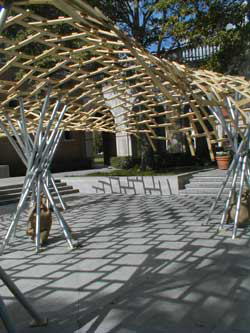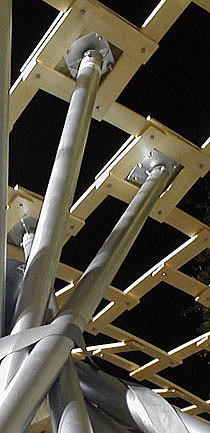WORKS - Others バンブー・ルーフ |
 |
 |
 |
This project for the Rice University Art Gallery began when Shigeru Ban was in Houston, Texas to give a lecture. Following the talk, he was asked by the director of the gallery, Kimberly Davenport, to design an installation on the campus. This is a 36' x 36' undulating canopy of interwoven bamboo boards.
Groups of four boards are overlapped in a spiraling pin-wheel connection, and different orientations of the overlap results in a change in curvature. This arrangement of pin-wheel connections creates a pattern of large and small squares, and forms a concave or convex geometry resulting in a shell structure or grid shell. The canopy is supported by columns composed of bundled steel poles. Eight poles are set in a radial arrangement connecting to plywood plates on the canopy which also act as a surface brace for the grid shell. The steel poles are bound at the center by a high-strength ratchet strap and extra weight was added to the whole structure by hanging burlap bags filled with gravel, to reinforce against the effects of uplift.
The off-the-shelf, bamboo boards were pre-cut and drilled before being shipped to the site, a 42’ x 42’ open plaza in front of the Art Gallery. The steel pole supports were prepared by graduate students from the University of Houston, and the canopy was assembled by architecture students of Rice University. The erection process took place in one day. The pre-assembled grid shell was hoisted in the air by crane as the steel pole supports were secured underneath.
This project contributed as a prototype for a permanent pavilion in Forest Park, St. Louis which is still under development. This project will utilize engineered laminated bamboo at twice the scale, and the overall size of the pavilion will be approximately ten times. The design of this structural concept was developed through the collaboration between Shigeru Ban and Cecil Balmond of Arup, London
スパイラル状に重ね合せ、ピンで留めた4枚の竹のボードを1ユニットとするこのキャノピーは大小の正方形パターンをもち、凸面と凹面をもつグリッドシェルとなる。このキャノピーは、セントルイスのフォレスト・パーク・パビリオンの2分の1のプロトタイプである。
|